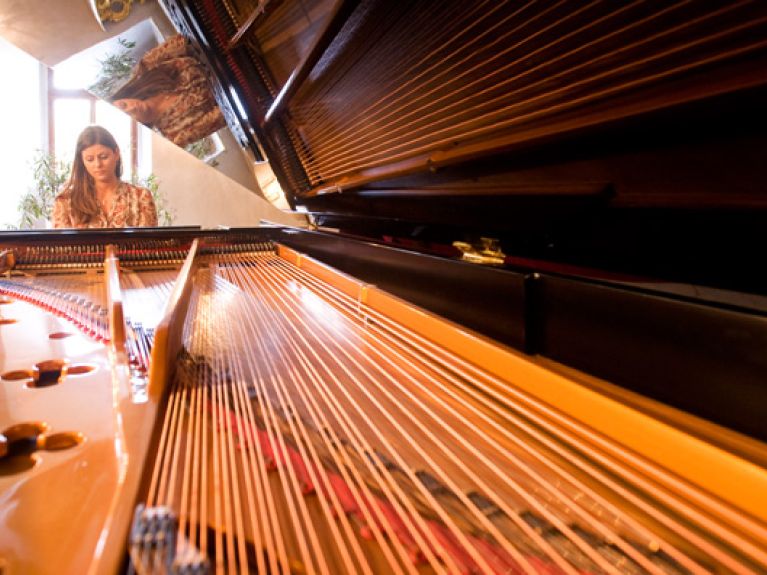The desire for quality
Although a land of industry, Germany is also home to skilled craftsmanship and fine manufactories.

Handmade products and manufactories
Craftsmanship will never die out although ever more accurate machines are being devised to perform work that was once exclusively done by human hand. For a long time work had no higher ethical or moral value – it was a curse, it was the punishment for the first humans’ rebellion against the creator. Adam and Eve were compelled to leave paradise, where there had been no work, to feed themselves “by the sweat of their brows”. “Adam delved and Eve span” – from then onwards humans struggled for survival with their hands, admittedly, however, ever higher and more comfortable forms of survival. Nevertheless, the dream remained of satiety and effortless leisure, of the Land of Cockaigne where grilled geese flew directly into the mouths of its blessed inhabitants. The vision of a world without effort and labour continued to be dreamt. The most beautiful privilege of the aristocracy was the fact that they did not have to labour. Even Saint Thomas Aquinas rebuked burghers not to do more work than was necessary for a way of life befitting their station. And because the need to work still continued to exist, the best European scholars constantly strove to find ways of eliminating this burden in order to return to the magnificent days of that legendary beginning – if necessary by cunning. Mekhane, the Greek work from which the word “machine” derives, actually means “contrivance”. The origin of the word itself therefore already contains the arguments that a subsequent critique of mechanization and its consequences would use against the world of machines.
What the philosophers, physicists and idealists contrived in order to abolish human labour eventually led to the work culture that left an unprecedented and indelible mark on the 19th and 20th centuries. Amazingly, however, this all-embracing victory of the machine also opened the door for our first glimpse of the value and the beauty of craftsmanship. There has been a reversal of values. The German word “Banause” originally meant “artisan” in Greek but came to be used to describe dull-witted philistines who reject all things artistic. Today, however, we believe that artisans were the foundation and mainstay of European culture. The form that our modern, technology-based work has taken allows us to perceive artisans as the very opposite of what they were seen for millennia – in other words, as artists. What has happened to the oppressive yoke under which humankind toiled at looms and in mills, workshops and smithies? Where has it gone? The view of an old workshop with its hand-forged tools, scratched wooden workbenches, black leather aprons, ovens and the small windows facing a cluttered, but well-organized back yard seems to offer a glimpse of a lost paradise – this perception makes clear just how deeply the industrial revolution has changed how we experience our world.
We should not overlook the fact that the noblest crafts have remained with us until the present in a form that stems from early industrialization. That is one of the paradoxes of history. Absolutist rulers, led by Louis XIV, created the manufactories, the first forms of serial production in which they brought together and rationally organized skilled artisans in larger units. Following the models of Sèvres and Beauvais, many significant manufactories were also established in Germany, some of which still exist today. The leading examples naturally include porcelain manufactories as well as those for clocks, glass and furniture. In the 18th century, for example, furniture from the Roentgen manufactory in Neuwied in southwestern Germany became world famous. Now, following the example of these old manufactories, a new movement of organized artisan production has arisen: fountain pens and musical instruments are today also frequently manufactured to the highest quality standards by hand.
Particular forms of production create people who are then considered typical for this kind of work. Today many young people are rediscovering skilled crafts because they have recognized that working with their hands produces results that cannot be achieved by machines. Craftsmanship acquires an almost magical quality wherever the beauty, splendour and uniqueness of an object are sought and appreciated. The hunched and limping tailor and the glum cobbler blinking in the bright light of day have now been replaced by confident proprietors of expensive and prestigious studios who have given their names to aftershave purveyed in sparkling crystal bottles. Crafts today offer a plethora of attractive and creative trades – but are these trades still actually exercised by craftsmen? Craft dynasties once arose on the same basis as royal dynasties. The son of the tailor became a tailor and he married the daughter or the widow of a tailor – the wife of the master craftsman was a queen and brought her fortunate suitor a kingdom – namely, membership of the guild. Apprenticeships began much earlier than today; in fact, they began with the child’s very first steps, when he stumbled around his father’s workshop and breathed in the air, full of the peculiarities and traditions of the trade and the way it had been exercised here in this particular town and workshop for centuries. These trades were not chosen freely following consideration of individual inclinations and opportunities on the labour market only then to be then possibly changed several times in the course of a life. It was a question of fate, character and a practical expression of the history and culture of a town or landscape.
Accordingly, much more than members of the other estates, artisans were the natural guardians of the peculiarities of the region from whence they came. They best knew the materials that their land brought forth; they knew the properties of the skins and the wool of the local animals because they knew what they ate; they knew the quality of the local stone and soil, the properties of the timber, the advantages and disadvantages of the climate; they knew which plants flourished best and the locations where the sun shone most. The tools of the craftsman were continuations of his limbs. The invention and development of tools arose not out of an analytical, but an observational examination of the human body. The handle of a knife or a hammer and the weight of a tailor’s shears or of pliers or pestle all derive from the most subtle studies of the human hand. The craftsman’s tools provide that unique pleasure of a perfectly distributed physical burden – its weight becomes manageable.
Having produced a precious object – a cupboard, a suit, a shoe, a loaf of bread, a barrel or a bell – entirely with one’s own hands and the right tools fills one with pride and the consciousness that one understands and masters one part of the world, no matter how small it may be. The experience of being able to create order among chaos by applying human senses and bodily strength empowers the craftsman to perform miracles that we still admire today: the building of the towns and villages of old Europe. Will the coming generations be capable of comparable creations using the strength of titans in a machine-based world?

